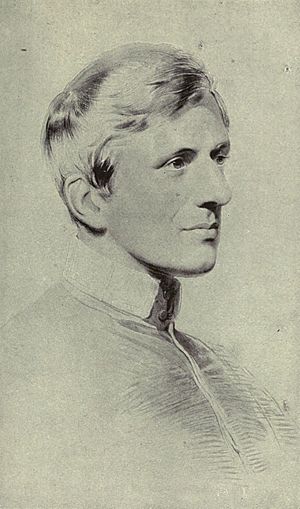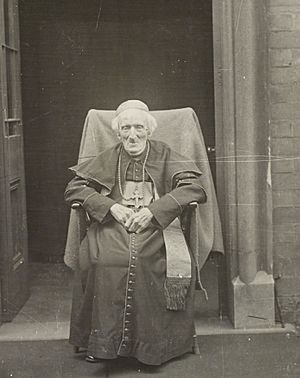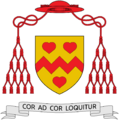John Henry Newman facts for kids
Quick facts for kids Saint John Henry Newman |
|
|---|---|
| 'Cardinal Doctor of the Church' |
|
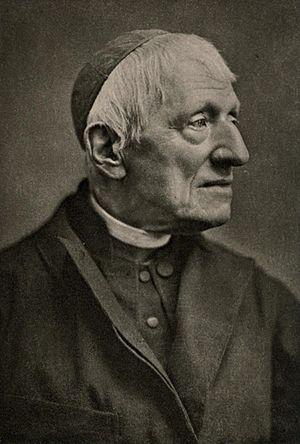
Photograph by Herbert Rose Barraud, c. 1885
|
|
| Church | Catholic Church |
| Appointed | 12 May 1879 |
| Reign ended | 11 August 1890 |
| Predecessor | Tommaso Martinelli |
| Successor | Francis Aidan Gasquet |
| Other posts |
|
| Orders | |
| Ordination |
|
| Created Cardinal | 12 May 1879 |
| Rank | Cardinal deacon |
| Personal details | |
| Born | 21 February 1801 London, England |
| Died | 11 August 1890 (aged 89) Edgbaston, Birmingham, England |
| Buried | Oratory Retreat Cemetery Rednal, Metropolitan Borough of Birmingham, West Midlands, England |
| Denomination |
|
| Parents |
|
| Education | Trinity College, Oxford |
| Motto | Cor ad cor loquitur ('Heart speaks unto heart') |
| Signature | |
| Coat of arms |  |
| Sainthood | |
| Feast day |
|
| Venerated in | |
| Beatified | 19 September 2010 Cofton Park, Birmingham, England by Pope Benedict XVI |
| Canonized | 13 October 2019 Saint Peter's Square, Vatican City by Pope Francis |
| Attributes | Cardinal's attire, Oratorian habit |
| Patronage | Personal Ordinariate of Our Lady of Walsingham; poets |
| Shrines | Birmingham Oratory |
John Henry Newman (21 February 1801 – 11 August 1890) was a very important English religious leader, writer, and poet in the 19th century. He began his career as a priest in the Church of England but made a famous decision to become a Catholic. He later became a cardinal, a high honor in the Catholic Church.
Newman was a brilliant thinker and writer. His books, poems, and sermons had a big influence on many people. He is known for popular hymns like "Lead, Kindly Light".
Because of his holy life and important writings, he was made a saint by Pope Francis in 2019. On November 1, 2025, Saint John Henry Newman was named a Doctor of the Church by Pope Leo XIV. This is a special title given to saints whose writings have greatly helped the Church.
Contents
Early Life and School Days
John Henry Newman was born in London, England, on February 21, 1801. He was the oldest of six children. His father was a banker, and his family was part of the Church of England.
As a boy, Newman loved to read books, especially the novels of Sir Walter Scott. When he was 15, he had a powerful religious experience that he said changed his life forever. From that point on, he dedicated his life to God.
After finishing school, he went to Trinity College, Oxford. He was a very good student and, after graduating, he became a fellow and tutor at Oriel College, Oxford, which was a center of great thinking at the time.
A Leader in the Church of England
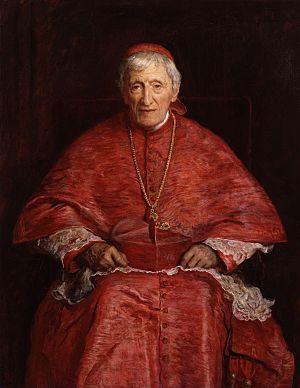
On June 13, 1824, Newman became a deacon in the Church of England, and the next year he was ordained as a priest. He served as the vicar (pastor) of the University Church of St. Mary the Virgin in Oxford. His sermons there became very famous and attracted many students.
The Oxford Movement
In the 1830s, Newman became a key leader of the Oxford Movement. This was a group of Anglicans who wanted to bring the Church of England back to some of the older beliefs and rituals it shared with the Catholic Church before the English Reformation.
To spread their ideas, Newman and his friends started writing a series of pamphlets called Tracts for the Times. These writings were very influential and caused a lot of discussion all over England.
However, in 1841, Newman wrote Tract 90, which argued that the main beliefs of the Church of England were not so different from Catholic teachings. This caused a huge controversy. Many people were upset, and the Bishop of Oxford asked him to stop publishing the tracts. This event made Newman begin to doubt his place in the Anglican Church.
Becoming a Catholic
Feeling uncertain, Newman moved out of Oxford in 1842 to a small religious community he set up in the nearby village of Littlemore. He and a few friends lived a simple life of prayer and study.
After a few years of deep thought and prayer, Newman made the most important decision of his life. On October 9, 1845, he was officially welcomed into the Catholic Church. This was a very difficult step for him. He lost his job at Oxford and many of his old friends, and even his own sister stopped speaking to him for a time.
Life as a Catholic Priest
In 1846, Newman traveled to Rome to study for the Catholic priesthood. He was ordained a priest in 1847. When he returned to England, he founded the first English house of the Oratory of St. Philip Neri, a community of priests, in Birmingham. He lived and worked there for almost 40 years.
University Founder
In 1854, Newman was invited to Dublin, Ireland, to help start a new university for Catholics, now called University College Dublin. He served as its rector (head) for four years.
During this time, he gave a series of lectures that were published in a famous book called The Idea of a University. In it, he shared his belief that education should not just be about learning facts for a job, but about training the mind to think clearly and understand the world.
Famous Writings
In 1864, a writer named Charles Kingsley accused Newman of not caring about the truth. To defend himself, Newman wrote his famous autobiography, Apologia Pro Vita Sua, which means "A Defense of His Life." In this powerful book, he explained his religious journey and the reasons for his conversion. The book was a great success and helped many people understand him better.
He also wrote a famous poem called The Dream of Gerontius, which tells the story of a soul's journey after death. It was later set to music by the composer Edward Elgar.
Later Years and Death
In 1879, Pope Leo XIII honored Newman by making him a cardinal. This was a sign of the Pope's great respect for Newman's life and work. Newman was very grateful but asked to be allowed to stay in Birmingham with his Oratory community.
Cardinal Newman died of pneumonia on August 11, 1890, at the age of 89. As he had wished, he was buried in the same grave as his lifelong friend, Ambrose St. John. The motto on his memorial stone reads Ex umbris et imaginibus in veritatem, which is Latin for "Out of shadows and images into the truth."
Sainthood and Legacy
John Henry Newman's ideas about faith, education, and conscience continue to influence people today. Many universities have "Newman Centers" for Catholic students, named in his honor.
The Catholic Church officially recognized his holy life.
- Beatification: In 2010, Pope Benedict XVI declared him "Blessed" after the Church confirmed a miracle happened through prayers to Newman.
- Canonization: On October 13, 2019, Pope Francis declared him a saint in a ceremony in St. Peter's Square.
- Doctor of the Church: On November 1, 2025, Pope Leo XIV gave him the special title of Doctor of the Church because of his wise and important teachings.
Saint John Henry Newman is remembered as one of the greatest religious figures of his time, a man who followed his conscience in search of the truth.
John Henry Newman quotes
- "Fear not that thy life shall come to an end, but rather fear that it shall never have a beginning."
- "A man would do nothing if he waited until he could do it so well that no one could find fault."
- "To live is to change, and to be perfect is to have changed often."
- "Prayer is to the spiritual life what the beating of the pulse and the drawing of the breath are to the life of the body."
- "When you feel in need of a compliment, give one to someone else."
- "We can believe what we choose. We are answerable for what we choose to believe."
- "Learn to do thy part and leave the rest to Heaven."
- "Let us act on what we have, since we have not what we wish."
Works by John Henry Newman
Here are some of the books and writings by John Henry Newman:
From His Anglican Period
- The Arians of the Fourth Century (1833)
- Tracts for the Times (1833–1841)
- British Critic (1836–1842)
- Lyra Apostolica (poems, 1836)
- On the Prophetical Office of the Church (1837)
- Lectures on Justification (1838)
- Parochial and Plain Sermons (1834–1843)
- Select Treatises of St. Athanasius (1842, 1844)
- Lives of the English Saints (1843–44)
- Essays on Miracles (1826, 1843)
- Oxford University Sermons (1843)
- Sermons on Subjects of the Day (1843)
From His Catholic Period
- Essay on the Development of Christian Doctrine (1845)
- Retractation of Anti-Catholic Statements (1845)
- Loss and Gain (novel – 1848)
- Faith and Prejudice and Other Unpublished Sermons (1848–1873; collected 1956)
- Discourses to Mixed Congregations (1849)
- Difficulties of Anglicans (1850)
- The Present Position of Catholics in England (1851)
- The Idea of a University (1852 and 1858)
- Cathedra Sempiterna (1852)
- Callista (novel – 1855)
- On Consulting the Faithful in Matters of Christian Doctrine (1859)
- The Rambler (editor) (1859–1860)
- Apologia Pro Vita Sua (religious autobiography – 1864; revised edition, 1865)
- Letter to Dr. Pusey (1865)
- The Dream of Gerontius (1865)
- An Essay in Aid of a Grammar of Assent (1870)
- Sermons Preached on Various Occasions (various/1874)
- Letter to the Duke of Norfolk (1875)
- Five Letters (1875)
- Sermon Notes (1849–1878)
- Select Treatises of St. Athanasius (1881)
- On the Inspiration of Scripture (1884)
- Development of Religious Error (1885)
Other Writings
- Historical Tracts of St. Athanasius (1843)
- Essays Critical and Historical (various/1871)
- Tracts Theological and Ecclesiastical (various/1871)
- Discussions and Arguments (various/1872)
- Historical Sketches (various/1872)
- Addresses to Cardinal Newman and His Replies, with Biglietto Speech (1879)
Selections of His Works
- Realizations: Newman's Own Selection of His Sermons (edited by Vincent Ferrer Blehl, S.J., 1964). Liturgical Press, 2009. ISBN: 978-0-8146-3290-1
- Mary the Second Eve (compiled by Sister Eileen Breen, F.M.A., 1969). TAN Books, 2009. ISBN: 978-0-89555-181-8
Images for kids
-
Statue outside the Church of the Immaculate Heart of Mary, also known as Brompton Oratory, in London
-
Newman's desk in the Birmingham Oratory
-
Newman's room in the Birmingham Oratory
See also
 In Spanish: John Henry Newman para niños
In Spanish: John Henry Newman para niños


